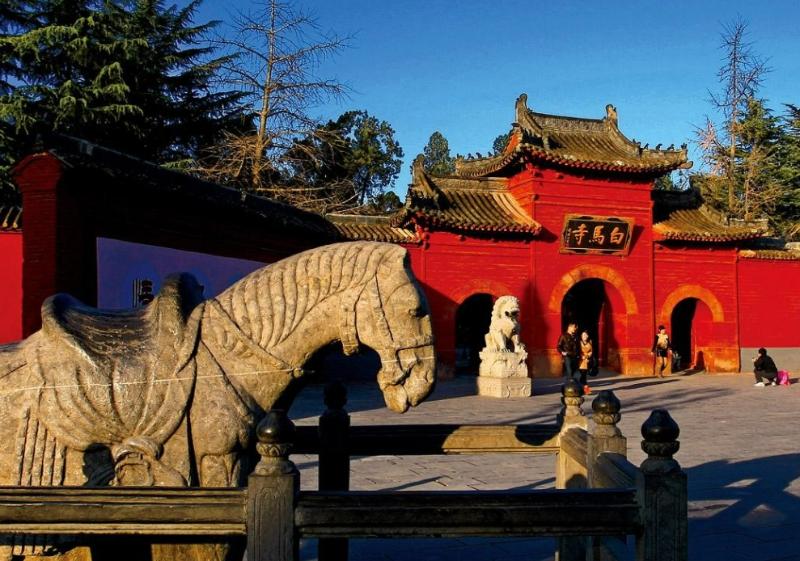White Horse Temple

I. Historical Origins
Foundation:
- The White Horse Temple, established during the late Western Han dynasty, stands as the first Buddhist temple in China, playing a pivotal role in the introduction and dissemination of Buddhism within the country.
- During the reign of Emperor Ming of the Eastern Han dynasty, emissaries were sent to the Western Regions to acquire Buddhist scriptures, which were brought back to China by a white horse, hence the temple's name.
- Emperor Ming commissioned the construction of the temple outside Luoyang to accommodate the scriptures and monks, providing a crucial platform for Buddhism's entry into China and laying the foundation for its development.
Historical Evolution:
- Since its inception, the White Horse Temple has undergone multiple renovations and reconstructions, navigating through periods of warfare and political shifts.
- After Emperor Xiaowen of the Northern Wei dynasty relocated the capital to Luoyang, he vigorously promoted Buddhism, leading to the temple's reconstruction and expansion.
- During the Tang dynasty, the White Horse Temple, designated as a royal temple, received significant attention and support from successive emperors, resulting in further expansion and its establishment as a center of Buddhist activity.
- Throughout the Song, Yuan, Ming, and Qing dynasties, the temple underwent numerous renovations, preserving a wealth of valuable artifacts and structures that bear witness to Buddhism's growth in China.
II. Architectural Distinctions
Layout:
- The White Horse Temple boasts a sprawling layout, meticulously designed in accordance with traditional Buddhist temple architecture. It is divided into distinct sections, including the Mountain Gate, Heavenly King Hall, Great Hero Hall, Vairocana Hall, Receiving Hall, Sakyamuni Hall, and Ancestor Hall.
- The primary structures are aligned along the central axis, flanked by corridors, auxiliary buildings, and courtyards, forming a cohesive and grand architectural complex.
Style:
- The White Horse Temple's architecture harmoniously blends elements of Han dynasty building styles with Buddhist architectural motifs, reflecting the distinct characteristics of Buddhist architecture during the Han and Jin dynasties.
- The temple's structures predominantly feature timber construction, incorporating intricate brackets, overhanging eaves, and elaborate carvings, creating a majestic and solemn atmosphere.
- The temple preserves structures with Tang dynasty architectural styles, such as the Great Hero Hall and Vairocana Hall, highlighting the remarkable achievements of Tang dynasty Buddhist architecture.
Key Structures:
- Mountain Gate: The temple's Mountain Gate, constructed during the Ming dynasty, is an imposing structure serving as the primary entrance to the temple.
- Heavenly King Hall: This hall houses statues of the Four Heavenly Kings, serving as the temple's guardian deities, symbolizing Buddhism's authority and power.
- Great Hero Hall: The main hall of the temple, the Great Hero Hall, enshrines the statue of Sakyamuni Buddha, a crucial destination for Buddhist devotees.
- Vairocana Hall: The central structure of the temple, the Vairocana Hall, houses the statue of Vairocana Buddha, embodying Buddhism's compassion and wisdom.
- Other Structures: The White Horse Temple also includes additional halls, such as the Receiving Hall, Sakyamuni Hall, and Ancestor Hall, each enshrining different Buddhist figures and ancestors, showcasing Buddhism's rich content and cultural heritage.
III. Cultural Significance
Center for Buddhist Propagation:
- As the first Buddhist temple in China, the White Horse Temple has played a monumental role in the introduction and dissemination of Buddhism within the country.
- The temple preserves a treasure trove of valuable Buddhist scriptures, including the Mulasarvastivada Vinaya and Mahasanghika Vinaya, serving as essential sources for studying Buddhism.
- The White Horse Temple has hosted numerous Buddhist gatherings, attracting countless monks and devotees, propelling the growth of Buddhism in China.
Bridge of Cultural Exchange:
- The White Horse Temple stands as a pivotal site for cultural exchange between China and other nations, signifying the integration of Buddhist culture into China and its fusion with traditional Chinese culture.
- The temple houses a collection of Buddhist artifacts originating from India, Central Asia, and other regions, reflecting the interchange and fusion of diverse cultures.
- As the birthplace of Chinese Buddhism, the White Horse Temple draws Buddhist devotees from across the globe, fostering exchanges between Chinese and international Buddhist cultures.
Historical and Cultural Legacy:
- The White Horse Temple, recognized as China's oldest surviving temple, holds significant historical and cultural heritage, encompassing its architecture, artifacts, and scriptures.
- The temple preserves structures with Tang dynasty architectural styles, showcasing the splendor of Tang dynasty Buddhist architecture.
- As a vital carrier of Chinese Buddhist culture, the White Horse Temple holds crucial importance for research into Chinese Buddhist history, architecture, and art.
IV. Tourism Value
Cultural Tourism Destination:
- The White Horse Temple, a prominent symbol of Chinese Buddhist culture, draws numerous tourists for visits and pilgrimages.
- The temple's rich cultural content, imposing architectural complex, and long history provide visitors with unique cultural experiences.
Historical Sites:
- As China's oldest temple, the White Horse Temple, with its long history and rich cultural content, attracts visitors who seek to learn about the development of Buddhism in China.
- The temple's preserved artifacts and structures showcase the allure of Buddhist culture and the vastness of Chinese culture.
Religious Sanctuary:
- The White Horse Temple, the birthplace of Chinese Buddhism, draws countless Buddhist devotees for pilgrimages, seeking to experience the power and charm of Buddhist culture.
- The temple's solemn atmosphere and abundant Buddhist culture offer visitors spiritual solace and comfort.
V. Conclusion
The White Horse Temple, the birthplace of Chinese Buddhism, bears witness to the growth of Chinese Buddhism and showcases the vastness of Chinese culture. Its long history, unique architectural style, and rich cultural content make it a significant cultural tourism destination in China, leaving a precious historical and cultural legacy for future generations.